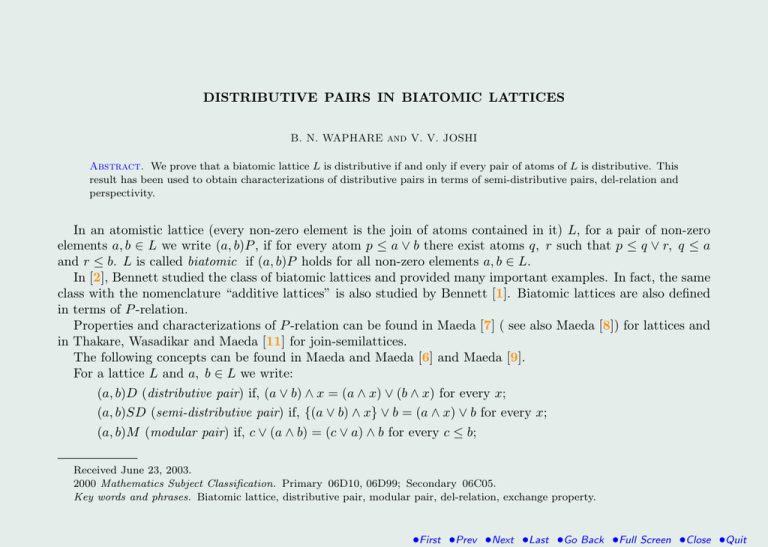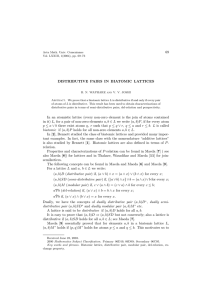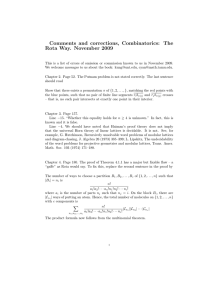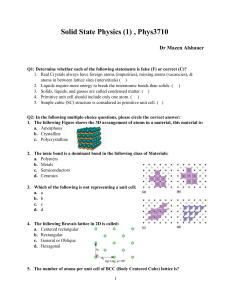DISTRIBUTIVE PAIRS IN BIATOMIC LATTICES
advertisement

DISTRIBUTIVE PAIRS IN BIATOMIC LATTICES
B. N. WAPHARE and V. V. JOSHI
Abstract. We prove that a biatomic lattice L is distributive if and only if every pair of atoms of L is distributive. This
result has been used to obtain characterizations of distributive pairs in terms of semi-distributive pairs, del-relation and
perspectivity.
In an atomistic lattice (every non-zero element is the join of atoms contained in it) L, for a pair of non-zero
elements a, b ∈ L we write (a, b)P , if for every atom p ≤ a ∨ b there exist atoms q, r such that p ≤ q ∨ r, q ≤ a
and r ≤ b. L is called biatomic if (a, b)P holds for all non-zero elements a, b ∈ L.
In [2], Bennett studied the class of biatomic lattices and provided many important examples. In fact, the same
class with the nomenclature “additive lattices” is also studied by Bennett [1]. Biatomic lattices are also defined
in terms of P -relation.
Properties and characterizations of P -relation can be found in Maeda [7] ( see also Maeda [8]) for lattices and
in Thakare, Wasadikar and Maeda [11] for join-semilattices.
The following concepts can be found in Maeda and Maeda [6] and Maeda [9].
For a lattice L and a, b ∈ L we write:
(a, b)D (distributive pair) if, (a ∨ b) ∧ x = (a ∧ x) ∨ (b ∧ x) for every x;
(a, b)SD (semi-distributive pair) if, {(a ∨ b) ∧ x} ∨ b = (a ∧ x) ∨ b for every x;
(a, b)M (modular pair) if, c ∨ (a ∧ b) = (c ∨ a) ∧ b for every c ≤ b;
Received June 23, 2003.
2000 Mathematics Subject Classification. Primary 06D10, 06D99; Secondary 06C05.
Key words and phrases. Biatomic lattice, distributive pair, modular pair, del-relation, exchange property.
•First •Prev •Next •Last •Go Back •Full Screen •Close •Quit
a∇b (del-relation) if, (a ∨ x) ∧ b = b ∧ x for every x;
˜ if, (a ∨ x) ∧ (b ∨ x) = x for every x.
a∇b
Dually, we have the concepts of dually distributive pair (a, b)D∗ , dually semi-distributive pair (a, b)SD∗ and dually
modular pair (a, b)M ∗ etc.
A lattice is said to be distributive if (a, b)D holds for all a, b.
It is easy to prove that (a, b)D ⇒ (a, b)SD but not conversely; also a lattice is distributive if (a, b)SD holds
for all a, b ∈ L; see Maeda [7].
Maeda [9] essentially proved that for elements a, b in a biatomic lattice L, (a, b)M ∗ holds if (p, q)M ∗ holds for
atoms p ≤ a and q ≤ b. This motivates us to prove analogues results for different concepts in lattices. In fact, in
this paper, we prove the following result in biatomic lattices.
Theorem 1. In a biatomic lattice L, the following statements are true for a, b ∈ L.
(α) If (p, q)D holds for all atoms p ≤ a and q ≤ b then (a, b)D holds.
(β) p∇q holds for all atoms p ≤ a and q ≤ b if and only if a∇b holds.
We use this result to obtain characterizations of distributive pairs in terms of semi-distributive pairs, delrelation and perspectivity.
For undefined notations and terminology the reader is referred to Maeda and Maeda [6].
To prove Theorem 1 we need:
Lemma 2. (Maeda [9]). Let a, b be elements of an atomistic lattice L. The following conditions are equivalent.
1. (a, b)D.
2. (a, b)SD.
3. For an atom p ∈ L, p ≤ a ∨ b implies p ≤ a or p ≤ b.
Proof of Theorem 1. (α): Suppose (p, q)D holds for all atoms p, q with p ≤ a and q ≤ b. Let p be an atom and
p ≤ a ∨ b. In view of Lemma 2, it is sufficient to prove that p ≤ a or p ≤ b. Suppose p 6≤ b. Since L is biatomic,
•First •Prev •Next •Last •Go Back •Full Screen •Close •Quit
there exist atoms q, r such that p ≤ q ∨ r with q ≤ a and r ≤ b. Clearly, p 6= r. Using p ≤ q ∨ r, p 6= r and (q, r)D
we have,
p = (q ∨ r) ∧ p = (q ∧ p) ∨ (r ∧ p) = q ∧ p.
Thus p = q ≤ a as required.
(β): Suppose a∇b holds and p, q are atoms such that p ≤ a and q ≤ b. For any x ∈ L we have
a∇b
(p ∨ x) ∧ q = [(a ∨ x) ∧ (p ∨ x)] ∧ (b ∧ q) = (a ∨ x) ∧ b ∧ (p ∨ x) ∧ q) = x ∧ (p ∨ x) ∧ b ∧ q =
x ∧ b ∧ q = x ∧ q.
Thus p∇q holds.
Conversely, suppose that p∇q holds for all atoms p ≤ a and q ≤ b. To prove a∇b, it is sufficient to show that
(a ∨ x) ∧ b ≤ x ∧ b. Suppose (a ∨ x) ∧ b 6≤ x ∧ b. Since L is atomistic, there exists an atom r such that r ≤ (a ∨ x) ∧ b
and r 6≤ x ∧ b. Since L is biatomic and r ≤ a ∨ x, there exist atoms p, q such that r ≤ p ∨ q, with p ≤ a and q ≤ x.
Clearly r 6= q. By p∇r and r ≤ p ∧ q, we have r = (p ∨ q) ∧ r = q ∧ r = 0, a contradiction.
We supply an example to show that the assertions of Theorem 1 are not true in a general atomistic lattice.
Example.
Let X be an infinite set with A, B complementary infinite subsets of X. Consider the set
L = {C ∪ D | C ⊆ A, C = B or C = X, D finite} ordered by set inclusion. In Janowitz and Cote [5], it is proved
that, L is an atomistic lattice in which every finite element (an element is called finite if it is either 0 or a join of
finitely many atoms) s is a standard element (i.e. (s, x)D holds for all x ∈ L; see Grätzer [4]). Therefore (p, q)D
holds for all atoms p, q of L. But the lattice is not distributive as the pair (C, B) is not distributive where C is
an infinite proper subset of A.
Also, it is shown in Janowitz and Cote [5] that B∇A does not hold. Now, we observe that p∇q holds for
all distinct atoms p, q in L. For this, note that in L, for an atom p, (p, x)D holds for all x ∈ L and therefore
(x, p)M ∗ holds. Now, we prove p∇q. By (x, p)M ∗ , (p ∨ q) ∧ (x ∨ p) = (((p ∨ q) ∧ x) ∨ p). Also, by (p, q)D,
(p ∨ q) ∧ x = (p ∧ x) ∨ (q ∧ x). Therefore (((p ∨ q) ∧ x) ∨ p) = p ∨ (q ∧ x). Thus (p ∨ q) ∧ (x ∨ p) = p ∨ (q ∧ x).
Taking meet with q and using (p, q)M we have the desired result.
Using Theorem 1(α) we obtain:
•First •Prev •Next •Last •Go Back •Full Screen •Close •Quit
Theorem 3. A biatomic lattice L is distributive if and only if (p, q)D holds for all atoms p, q ∈ L.
We provide a relationship between distributive pairs and the concept of perspectivity.
Let a and b be elements of a lattice L with 0. We say that a, b are perspective and write a ∼ b, when
a ∨ x = b ∨ x and a ∧ x = b ∧ x = 0 for some x ∈ L.
Lemma 4. Let a and b be elements of a modular atomistic lattice L. The following three statements are
equivalent.
1. a∇b.
2. There do not exist non-zero elements a1 and b1 such that a1 ∼ b1 , a1 ≤ a and b1 ≤ b.
3. There do not exist atoms p and q such that p ∼ q, p ≤ a and q ≤ b.
Proof. Using Lemma 11.1 of Maeda and Maeda [6] and the fact that del-relation is symmetric in modular
lattices, the result can be proved on the similar lines of Theorem 10.5 of Maeda and Maeda [6].
Remark 5. Note that the above result can be found in Maeda and Maeda [6] for an atomistic SSC ∗ (dually
section semi-complemented) lattice. Stern [10] essentially proved that a modular atomistic lattice of finite length
is dually atomistic (therefore SSC ∗ ). However, this assertion is not true if we drop the assumption of finiteness.
In this context we provide the following example.
Example. Let X be an infinite set. Put L = { F | F is a finite subset of X} ∪ {φ}. Then L forms a lattice
under the set inclusion. Moreover, it is easy to observe that L is an atomistic modular lattice which is not SSC ∗ .
The following result is proved in Bennett [2].
Lemma 6. In an atomistic lattice L the following statements are equivalent.
1. L is modular.
2. L is biatomic with the exchange property (If p and q are atoms, p 6≤ a and p ≤ a ∨ q ⇒ q ≤ a ∨ p.).
•First •Prev •Next •Last •Go Back •Full Screen •Close •Quit
Observe that Lemma 6 can also be deduced immediately from Lemma 4 of Maeda [8]; (see also Maeda [7]).
We also need the following lemma which is essentially proved by Crawley and Dilworth [3, p. 145].
Lemma 7. Let L be a modular lattice with 0 and a, b ∈ L with a ∧ b = 0. Then (a, b)D if and only if a∇b.
Now, we prove our main result.
Theorem 8. Let L be a biatomic lattice with the exchange property. Let a, b ∈ L and a ∧ b = 0. Then the
following statements are equivalent.
(1) (a, b)D.
(2) (a, b)SD.
(3) p ≤ a ∨ b imply p ≤ a or p ≤ b for an atom p ∈ L.
˜
(4) a∇b.
(5)
(6)
(7)
(8)
a∇b.
(p, q)D for all atoms p ≤ a and q ≤ b.
(p, q)SD for all atoms p ≤ a and q ≤ b.
p∇q for all atoms p ≤ a and q ≤ b.
˜ for all atoms p ≤ a and q ≤ b.
(9) p∇q
(10) There do not exist atoms p and q such that p ∼ q, p ≤ a and q ≤ b.
(11) There do not exist non-zero elements a1 and b1 such that a1 ∼ b1 , a1 ≤ a
and b1 ≤ b.
Proof. Equivalence of the first three statements follows from Lemma 2. The statements (1) and (5) are
equivalent by Lemma 6 and Lemma 7.
(4) ⇒ (5) is obvious.
•First •Prev •Next •Last •Go Back •Full Screen •Close •Quit
(5) ⇒ (4) : Suppose a∇b holds. By (b, x)M ∗ (whih holds due to Lemma 6) and a∇b we get (a ∨ x) ∧ (b ∨ x) =
[(a ∨ x) ∧ b] ∨ x = (x ∧ b) ∨ x = x. Thus the statements (1) to (5) are equivalent. On the similar lines equivalence of
the statements (6) to (9) can be proved. By Theorem 1(β), the statements (5) and (8) are equivalent. Equivalence
of the statements (5), (10) and (11) follows from Lemma 4.
Acknowledgements. The authors are thankful to Professor N. K. Thakare and the learned referee for their
valuable suggestions.
1.
2.
3.
4.
5.
6.
7.
8.
Bennett M. K., On generating affine geometries, Alg. Univ., 4 (1974), 207–219.
, Biatomic lattices, Alg. Univ., 24 (1987), 60–73.
Crawley P. and Dilworth R. P., Algebraic Theory of Lattices, Prentice Hall, Inc., Englewood Cliffs, N.J., 1973.
Grätzer G., General Lattice Theory, Birkhäuser Verlag, Second Edition (1998).
Janowitz M. F. and Cote N. H., Finite-distributive atomistic lattices, Portug. Math., 35 (1976), 81–91.
Maeda F. and Maeda S., Theory of Symmetric Lattices, Springer-Verlag, Berlin Heidelberg, New York. (1970).
Maeda S., On finite modular atomistic lattices, Alg. Univ. 12 (1981), 76–80.
, On modularity in atomistic lattices, in Contribution to lattice theory, Colloq. Math. Soc. Janos Bolyai, 33 (1983),
627–636.
9.
, On distributive pairs in lattices, Acta Math. Acad. Sci. Hung. 45 (1985), 133–140.
10. Stern M., On dually atomistic lattices, Discrete Math. 93 (1991), 97–100.
11. Thakare N. K., Wasadikar M. P. and Maeda S., On modular pairs in semilattices, Alg. Univ. 19 (1984), 255–265.
B. N. Waphare, Department of Mathematics, University of Pune, Pune 411 007, e-mail: bnwaph@math.unipune.ernet.in
V. V. Joshi, Department of Mathematics, Government College of Engineering, Pune 411 005, e-mail: vinayakjoshi111@yahoo.com
•First •Prev •Next •Last •Go Back •Full Screen •Close •Quit







